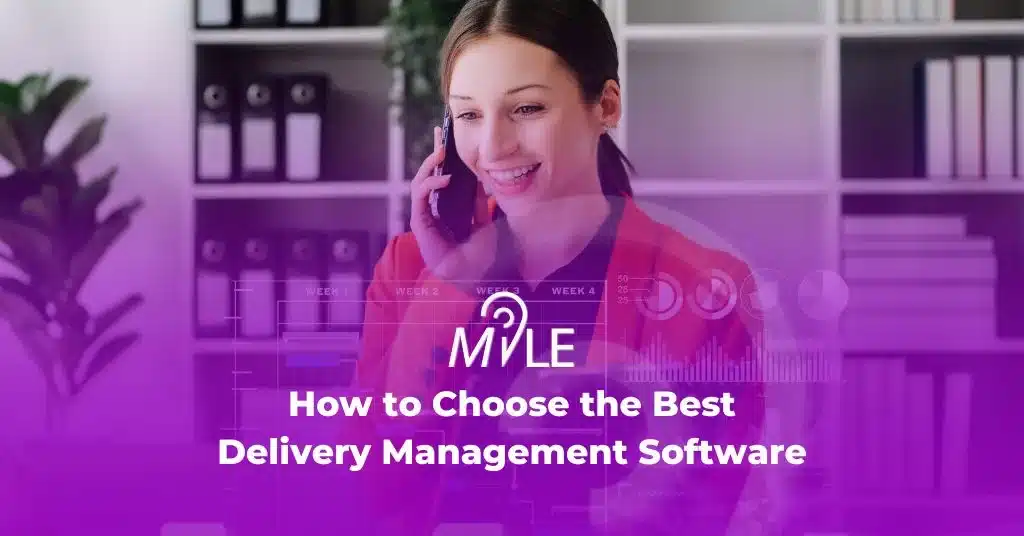How to Choose the Best Delivery Management Software

Let’s dive right into it: how to choose the best delivery management software.
A delivery management software streamlines and automates the entire logistics chain, thus ensuring that goods reach the customer’s doorstep safely and on time. By empowering fleet operators management of their end to end logistics value chain, including all aspects of delivery from a central dashboard for job assignment, route planning, real-time tracking, or electronic proof of delivery, a delivery management software increases business efficiency and reduces operational costs considerably.

That being said, today’s competitive supply chain environment requires fleet operators and distribution companies to select the right software to optimize operations and meet consumers’ changing needs.
This post will discuss important considerations and key features that will guide you on how to choose the best delivery management software for your company.
Key Considerations
If you want a logistics solution that fits right into your business and gives you a competitive edge, consider the following aspects:
Deployment Type
Choose between on-premise and cloud deployment for delivery management software based on your organization’s needs. On-premise offers localization but demands high upfront investment, and maintenance costs, while cloud-based software provides flexibility and accessibility with remote hosting usually requiring a third-party provider. Evaluate priorities like infrastructure expenses, flexibility, security risks, and control to decide the ideal deployment method for your enterprise software.
Enterprise Size
Beyond the primary benefits of paperless workflows, affordability, and ease of use, a delivery management software must have the required functionality to scale up and down a few features based on factors such as their daily usage, operational cost, etc. While small businesses can make do with limited features, large corporations need advanced capabilities like real-time tracking, automated routing, strategic reporting, and integrations with existing enterprise resource planning (ERP), accounting, and other systems to handle greater complexity and scale. You know the size of your business better. Choose wisely.
Industry Focus
A delivery management software must cover a unique business workflow for your specific industry to address your specific challenges in order to optimize operations accordingly. For instance, real-time tracking, dynamic route optimization, and predictive dispatch are all must-have features in a solution for the courier industry. On the other hand, the FMCG distribution industry may prioritize time-sensitive and temperature-controlled delivery options, dynamic routing, and compatibility with existing ERP solutions. The best delivery management software will be able to adjust to all business requirements.
Key Features
Here are some key features to look for when choosing the best delivery management software for your business.
- Real-Time Visibility
Look for a delivery management software that provides real-time insights into all critical shipment and driver metrics. Mile, for instance, offers advanced live tracking with replayability to give the stakeholders complete visibility of past and present operational data. Its configurable geofencing feature allows setting territorial boundaries and trigger alerts as and when a vehicle enters or leaves an authorized area, so that everyone, including the customer, knows the whereabouts of their shipments.
- AI-Powered Dispatching
AI-powered dispatch software optimizes routes by analyzing vehicle capacity, distance from pickup or delivery locations, driver availability, thereby reducing travel time and fuel consumption. It also adapts assignments in real-time based on advanced criterions to recalculate routes swiftly to minimize delays in delivery schedules. Mile takes it a step further by adding vehicle load, weight, and volume capacity utilization to the mix and assigning zones strategically to save drivers’ time and cost per trip.
- Electronic Proof of Delivery (POD)
A proof of delivery is the receipt that confirms an item’s successful delivery. In electronic POD, drivers capture the customer’s signature to record proof digitally. They can also snap images of customer identification, delivered package, or location as proof for issue resolution.
Mile’s electronic signatures and multiple images POD feature allows field force to be able to eliminate manual verification steps, freeing up their schedule for more deliveries.
- Localised Capabilities
A delivery management software’s localised packages help streamline usage for teams operating globally by adapting languages, currencies, taxation formats, and other regional regulations. Mile’s language-level customisation simplifies software rollout globally and makes life easier for non English speaking customers.
- Predictive Analyses
Mile uses advanced algorithms to examine historical operational data and forecast zone specific needs based on several factors, including item level requirements, average cost of delivery, warehouse capacity, inventory velocity, and customer order cycle time. Predictive load analysis and sales volume predictions also provide actionable insights on how to properly store incoming goods, stock inventory, utilize warehouse and vehicle capacity, and make other major decisions.
See Mile in Action
Mile is an end-to-end logistics management software that automates first, middle & last mile operations for fleet operators of all sizes. Our powerful, robust, and scalable platform solves the biggest challenges of fleet operators i.e accurate order fulfillment, on-time delivery, and optimal fleet utilization.
Schedule a demo and start saving money and time in your operations today!
